
Product test
The Bambino Mio cloth nappies tested
by Anne Fischer

I use between six and ten nappies each day for my two children, primarily Pampers. I put four Pampers products to the test and discovered a few drawbacks. But I still use them. Why?
The topic of which nappy is the best is as contentious as whether Zurich's «Hönggerberg» is really a mountain. Some people started using Pampers nappies and stuck with them, while others are unhappy yet persist nevertheless. Others still have switched to other brands for value for money or quality reasons. And then there are the parents who never or rarely use disposable nappies, using reusable nappies on principle.
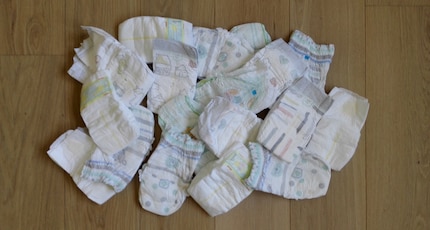
Even if you've used Pampers before, it's difficult to keep up with the wide range of products on offer. What's available, and which nappy delivers on its promises? This is why I picked out two ordinary nappies with fastenings from our product range, «Premium Protection» and «Pure Protection», and two pull-up styles, «Baby Dry Pants» and «Premium Protection Pants», and put them all to the test for you.
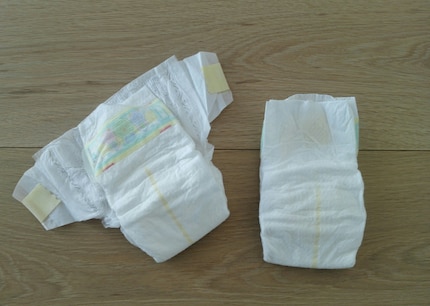
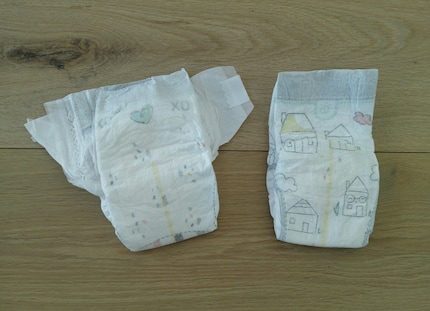
The advantage of both of these products is that they can be fastened with the two adhesive strips on the sides. This means you don't have to take off trousers or tights for changing, saving a huge amount of time during the day. Another benefit of the adhesive strips becomes clear when the nappy is full. You can then roll it up along with its contents and secure it with the strips to prevent any smelly spillages. The package won't fall apart, it's easy to dispose of and your hands will stay clean. The downside of nappies with adhesive strips is that they don't tend to cling so well to the child's bottom. Unfortunately, this results in my little ones frequently ending up with poo up their backs. There's only one thing for it in those situations: clothes off and into the bath!
Both nappies have a yellow urine indicator strip which turns blue when the nappy is wet. However, to make the most of this feature, you have to take the child's clothes off or pull them to one side first. The strip can definitely be helpful to start with, but with more experience you'll be able to quickly identify a full nappy with a quick touch of the hand.
Unfortunately, the Premium Protection doesn't always keep moisture at bay during the night, so my children's pyjamas often end up damp and even their sleeping area can sometimes be left soggy. I haven't used Pure Protection nappies long enough to evaluate them. For these reasons, I recommend the Baby Dry for nighttimes. Even these nappies don't provide 100% certainty, but they have worked the best for me during day and night, even without a urine indicator.
The Premium Protection is white with a colourful animal strip for aesthetics alongside the urine indicator on the front. This design has been spruced up on the new Pure Protection version. If you're looking for nappies with style as well as substance, this is the range for you. It's now also made with cotton. Find out more about the Pure range (in German):
But be warned: the cotton content and the new design are reflected in the price. It's up to you to decide whether the higher price tag is justified.
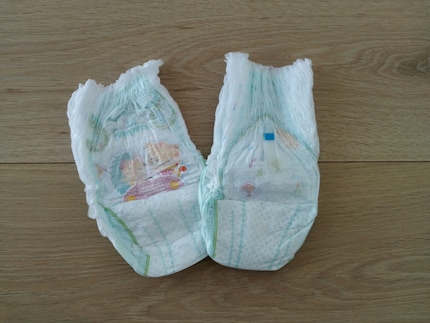
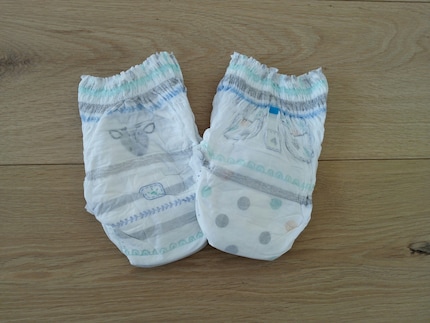
Baby Dry Pants are available from size 3 and Premium Protection Pants from size 4. Babies start to move around more from six months of age. Rolling, crawling and eventually taking those first few steps are all on the agenda and nappies have to adapt to this level of activity. These pants are pull-up nappies, which can be put on and taken off like underwear. The flexible band means that they cling well to your little one's bottom, so there are no or far fewer poo-up-the-back incidents. These stretchier nappies are thinner. Unfortunately, this means that the poo can escape if you don't notice a full nappy straight away. Then you'll realise that a new nappy is required ;-)
This type of nappy is ideal for potty training, as your little one can pull them up and down on their own. Before this point, though, they're a bit cumbersome. Because changing nappies without taking off trousers or tights becomes a circus act. Free one leg, rip the filled nappy open at the sides, clean the area, secure the clean nappy around the one leg, pull the trousers or tights down, secure the other leg, move the child to and fro or stand them up and, finally, pull up the tights or trousers. Alternatively, remove all clothes on the bottom half and put them back on afterwards. The second variant make sense for very full nappies or if your child likes to wriggle. Either way, putting on the pants while the child is lying down is really tricky.
What bothers me about the pants is the fact that I have to rip them open at the sides. This makes them almost impossible to roll up, especially when they're full to the brim. However, the narrow adhesive strip on the back does its job to hold it together and stop it coming undone. Nevertheless, runnier poo is an issue, as it can run out of the sides. There's a high probability that you'll end up putting your fingers in it during disposal. It's also tricky to work out the sizing for Baby Dry Pants. A tiny, hidden number on the side displays the size. If you don't know where it is, you'll miss it. This is integrated into the new design for the Premium Protection Pants.
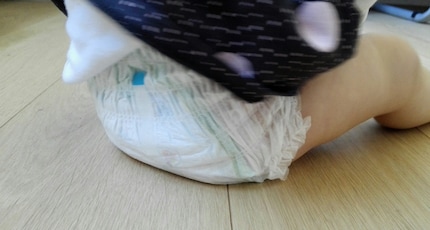
Unfortunately, none of the nappies totally won me over. Each one has its advantages and drawbacks. And although I've used quite a few other brands, I've always come back to Pampers. Is it the brand, the product, the comfort level, the price or just the sense that they all have the same purpose? I don't know. But after thousands of nappies, I've decided on two: the Baby Dry or the Premium Protection with adhesive strips – whichever is on offer – and the Baby Dry Pants. I use the pants for my eldest, who only needs a nappy at night now, and the other two types for my youngest. And I'll gradually move over to the pants for her too as she starts to move more and more, despite its negative points. For me, it's more important that a nappy is comfortable and the content doesn't go up my child's back than whether or not it's tricky to put on. The new Pure Protection nappies are nice to look at and feel good, but I don't think they're worth the price. In the end, they're just for collecting your little one's wee and poo.
Do you see nappies the same way? Do you have any other tips for fellow parents? Let me know in the comment field. Follow my profile and you'll never miss another article on babies and toddlers.
I’m the cook, cleaner, police officer, nurse, entertainer, motivator, author, storyteller, coach, organiser, chauffeur, lawyer and judge. To put it simply, I’m a mum to a daughter and not just a (Content) Manager at the office but also at home.